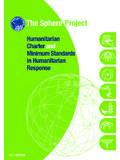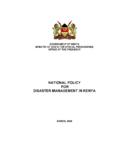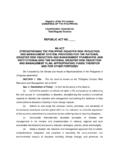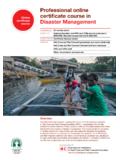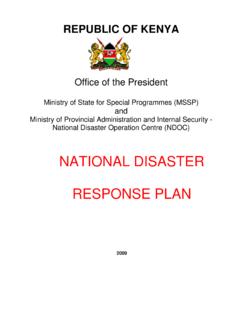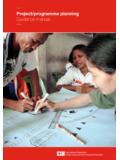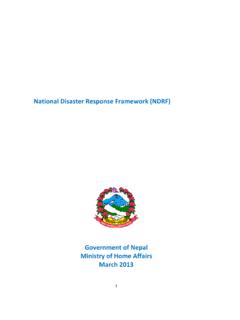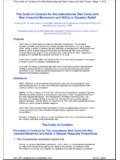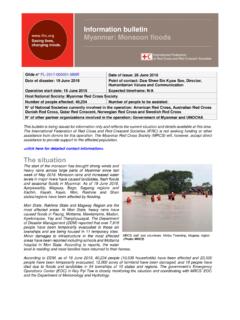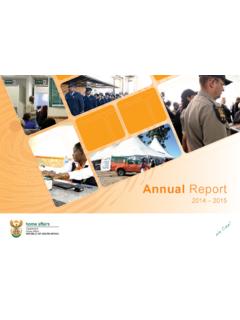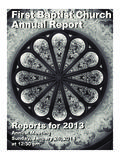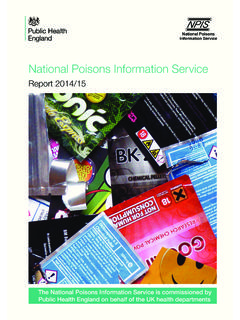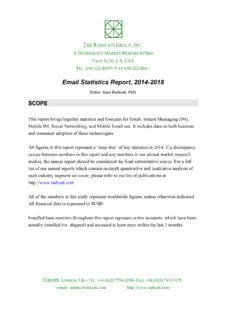Transcription of International Federation of Red Cross and Red Crescent ...
1 International Federation of Red Cross and Red Crescent Societies annual report lives, changing affected by the 25 April earthquake in Nepal receive relief goods from the the Nepal Red Cross Society and Danish Red Cross . Photo: Sebastian Noel WE AREThe International Federation of Red Cross and Red Crescent Societies (IFRC) is the world s largest volunteer-based humanitarian network. With our 190 member National Red Cross and Red Crescent Societies worldwide, we are in virtually every community reaching million people annually through long-term services and development programmes, as well as 110 million people through disaster response and early recovery programmes. We act before, during and after disasters and health emergencies to meet the needs and improve the lives of vulnerable people. We do so with impartiality as to nationality, race, gender, religious beliefs, class and political opinions.
2 Guided by Strategy 2020 our collective plan of action to tackle the major humanitarian and development challenges of this decade we are committed to saving lives and changing minds. Our strength lies in our volunteer network, our community-based expertise and our independence and neutrality. We work to improve humanitarian standards, as partners in development, and in response to disasters. We persuade decision-makers to act at all times in the interests of vulnerable people. The result: we enable healthy and safe communities, reduce vulnerabilities, strengthen resilience and foster a culture of peace around the world. International Federation of Red Cross and Red Crescent Societies, Geneva, 2016 Any part of this annual report may be cited, copied, translated into other languages or adapted to meet local needs without prior permission from the IFRC, provided that the source is clearly stated.
3 Requests for commercial reproduction should be directed to the IFRC at photos used in this report are copyright of the IFRC unless otherwise infographics have been developed based on graphic resources from , an online icons library. These icons have been provided for free use and the IFRC would like to warmly thank the Noun team and all designers who developed icons which helped us to create relevant infographics. All designers credits can be provided on demand at photo: Migration in Europe: Farah and her parents are from Iraq. Each day they come to wait at the police station to find out if their registration process is complete. Photo: Stephen Ryan/IFRC1309700 07/2016 E ISBN: 978-92-9139-239-1 TABLE OF CONTENTSFOREWORD 4 OPERATIONAL report : A YEAR OF International RESPONSE 8 STRATEGIES, OUTCOMES AND ACHIEVEMENTS 16 STATUTORY MEETINGS 28 GLOBAL STRATEGIC PARTNERSHIPS 30 FINANCES 34 FUNDAMENTAL PRINCIPLES 39 annual report 2015 International Federation of Red Cross and Red Crescent Societies annual report 20154 > FOREWORDA small boy, lying face down on a Turkish image of young Alan Al-Kurdi, dead after the boat carrying him and his family sank en route to Greece, shocked the world.
4 It brought attention to the migration crisis on the shores of Europe, cutting through at least for a time the divisive rhetoric that had masked this humanitarian served as a reminder of how deeply interconnected we are and of how suffering in one country or one region can have ramifications across the globe. It called to our collective humanity, to our shared s death, and the suffering and despair of the more than one million people who turned to Europe in search of safety and dignity, cannot be separated from the conflict, poverty and persecution that has spread and deepened in recent years. Families fleeing the fear and violence of Syria, Iraq and Afghanistan; families fleeing the poverty and inadequate opportunities of West Africa or South Asia; families and individuals fleeing the persecution and discrimination that is too prevalent in too many world on the moveBy the time of Alan s death, hundreds of thousands of people had already risked their lives to enter Europe.
5 It was a crisis that was in many ways predictable, and indeed it was something that we had foreseen. Our volunteers had witnessed first-hand the rising numbers of people arriving on the shores of Italy and Greece. They had seen the rising demands for their services in western and northern Europe. They had also seen the increase in traffic along migration routes through the Middle East, and across the Sahara and into North phenomenon goes well beyond Europe and Africa, however. As in years prior, National Societies responded to the needs of migrants who braved other treacherous seas the Gulf of Aden, the Bay of Bengal, the Indian Ocean, to name a few. And they brought life-saving medical attention, water and food, and family reunification services to migrants traveling through Central Red Cross and Red Crescent was present, has been present, at all points along these dangerous journeys.
6 The red Cross and red Crescent are emblems of hope and relief for hundreds of thousands of people. In the face of crisis, we are there. Always there, all the timeWhile the world s attention was undoubtedly focused on migration, 2015 also saw a number of other major Elhadj As Sy Secretary GeneralTadateru Kono PresidentFOREWORD5 annual report 2015 International Federation of Red Cross and Red Crescent Societies annual report 2015humanitarian emergencies. And for each of these, National Societies were at the frontline. In March, Red Cross volunteers in Vanuatu, Tuvalu, Fiji and the Solomon Islands helped communities prepare for, and respond to, Cyclone Pam. In April, the Nepal Red Cross Society led a truly Movement-wide response to the earthquakes that struck the Kathmandu valley. Within minutes, Red Cross volunteers were digging for survivors in the rubble.
7 Within hours, first aid posts were established. Within days, support from around the world arrived. As the emergency phase abated, the Red Cross and Red Crescent focus turned to recovery and to the long-term needs of are just two examples of the impact of our network throughout 2015 . These responses were mirrored countless times during the year, in response to events both large and small, and many more responses are highlighted in this value of localNational Societies are permanent and integral parts of their communities. As a result, they are usually the first to respond to emergencies, and they remain long after International aid organizations have packed and gone. This permanent presence is central to our unique identity. No other organization can claim to be present in 190 countries around the world, active in tens of thousands communities, and linked globally to a network of solidarity and tremendous 2015 , a series of International processes put the value of our network at the forefront.
8 In March, the Third UN World Conference on Disaster Risk Reduction adopted the Sendai Framework for Disaster Risk Reduction. This agreement makes explicit reference to the crucial role of National Red Cross and Red Crescent Societies in addressing disaster risk at the community Sustainable Development Goals (SDGs), adopted by United Nations Member States in September, place great emphasis on reaching the most isolated and most vulnerable people. National Societies and the IFRC will have a critical role to play in bridging the gaps between governments and remote communities. This agenda was a central part of the discussions that led up to the 2016 World Humanitarian Summit. Throughout 2015 , in various WHS forums, the IFRC advocated strongly for the need to increase support for, and recognition of, national humanitarian for humanityThe year ended with the Movement s Statutory Meetings in Geneva.
9 At the IFRC General Assembly, National Societies gathered to discuss a number of issues of common concern, and to endorse a new strategic plan and budget for the organization. The Council of Delegates the Movement s highest decision-making body endorsed a series of measures that will bring greater coherence and efficiency to our Movement, including a new framework on cooperating in emergencies, and a new Movement 32nd International Conference brought representatives of States Party to the Geneva Conventions together with all components of the Movement. The conference adopted a series of Resolutions that will strengthen our response to humanitarian crises, improve the way humanitarians and governments prevent and respond to sexual and gender-based violence in emergencies, prioritize the safety and security of humanitarian volunteers, and strengthen legal frameworks for disaster response, risk reduction, and first aid.
10 The conference also reaffirmed the relevance and importance of our seven Fundamental Principles, which marked their 50th anniversary in 2015 and which continue to define our approach to humanitarian action. Looking aheadThe IFRC was a strong voice in all of these processes. It is our sincere hope that these changes will deliver for the communities that rely on all of us for survival and support. This is the ultimate test. We should never forget the young boy on the beach, and the many other boys and girls who hope for a better Kono Elhadj As SyPresident Secretary GeneralANNUAL report 2015 International Federation of Red Cross and Red Crescent Societies annual report 20156 > THE IFRC IN NUMBERSNew YorkPort-au-PrinceBrusselsBudapestGeneva Ciudad GuatemalaTe gucigalpaMoscowTunisNew DehliBangkokKuala LumpurPretoriaJakarta SelatanSuvaAddis AbabaYaound AbujaDakarLimaPort-of-SpainBrasiliaDusha nbeBeijingDemocratic People sRepublic of KoreaOf cesUN, EU and AU officesCountry officeCountry cluster support teamRegional officeHeadquartersPanama CityRegionsAfricaAmericasAsia PacificEuropeMiddle East and North AfricaBeirutIFRC locationsAs of June 2016 Not included.
